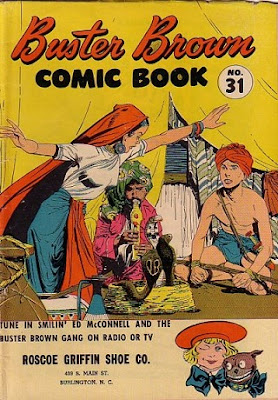It was sponsored by Buster Brown Shoes, an attempt to get kids interested in the most boring item of clothing imaginable: an elderly Little Person in an Edwardian sailor suit would say -- very slowly:
"I'm Buster Brown....I live in a sho....He's my dog Tige....He lives in there too.
The crazy advertising mascot derives from Buster Brown, an early 20th century comic strip (1902-1921) about a mischievous boy who has adventures and then writes a "resolution" to behave more appropriately in the future.
Like many tv series of the 1950s, it had a predecessor on radio, Smilin' Ed's Buster Brown Show (1944-1953), with Smilin' Ed McConnell hawking the shoes and reading the adventure stories.
With a tie-in comic book, Buster Brown Comics. 45 issues were published between 1945 to 1946. You could get them for free at local shoe stores and department stores, which conveniently printed their addresses on the front cover -- presumably while picking up your comic, you (or Mom) would do some shopping.
Each issue featured a humorous story starring Smilin' Ed and the Gang, plus an adventure story starring a muscular teenage boy: "Leathern Cord of Magic," "Dude Ranch Desperado," "Leopard Men," "Desert Raiders," "Ghanga the Elephant Boy."
Most were scripted by Hobart Donovan, the head writer of Smilin' Ed's gang, and the husband of voice actress June Foray (best known for Rocky and Bullwinkle). A number of artists drew the stories, including Ruben Moreira, Ray Willner, and future fantasy illustrator Frank Frazetta.
Remember, this was an era where movies never showed shirtless men except an occasional Tarzan or Bomba the Jungle Boy, and tv was a small black-and-white box with ghostly, hard-to-see images. Comic books were your only source of beefcake images.
And you could get free beefcake comics every other month just by dropping in to a shoe store.
Sounds bizarre, but sign me up!






There was also a 1905 broadway play based on the strip, also called "Buster Brown".
ReplyDeleteWhat I find interesting, for censorship reasons, is that they actually showed him naked on the cover of the swimming one. Mostly because the men of my generation are even-split on nudity, with half being the type to chill even a shared apartment naked, and the other half shower in trunks. (Insert Hajime no Ippo "bare naked" reference here.)
ReplyDeleteI also like how very Interregnum the art is, cartoon lightning bolts to represent magic.
Why does the dog have human teeth? And the dog smiles.
I'm going to guess these don't have any established canon, just a collection of unrelated stories the way a lot of pre-Silver Age comics were.
Interesting to see marketing in the pre television age- and yeah I guess you are right shirtless men always sell even boring shoes
ReplyDeleteI imagine that the dog has human teeth because that's the only way they could depict a recognizeable smile in a small icon.
ReplyDeleteCould be. My grandmother remembered Buster Brown as a kid. The Interregnum (basically V-J Day to the Comics Code) was apparently when the medium diversified. But a LOT of genres were impossible afterward. What's left, superheroes, some lighthearted comedy, and slice of life books like Archie, was all that was left. Which is why my manga collection is more diverse.
Delete